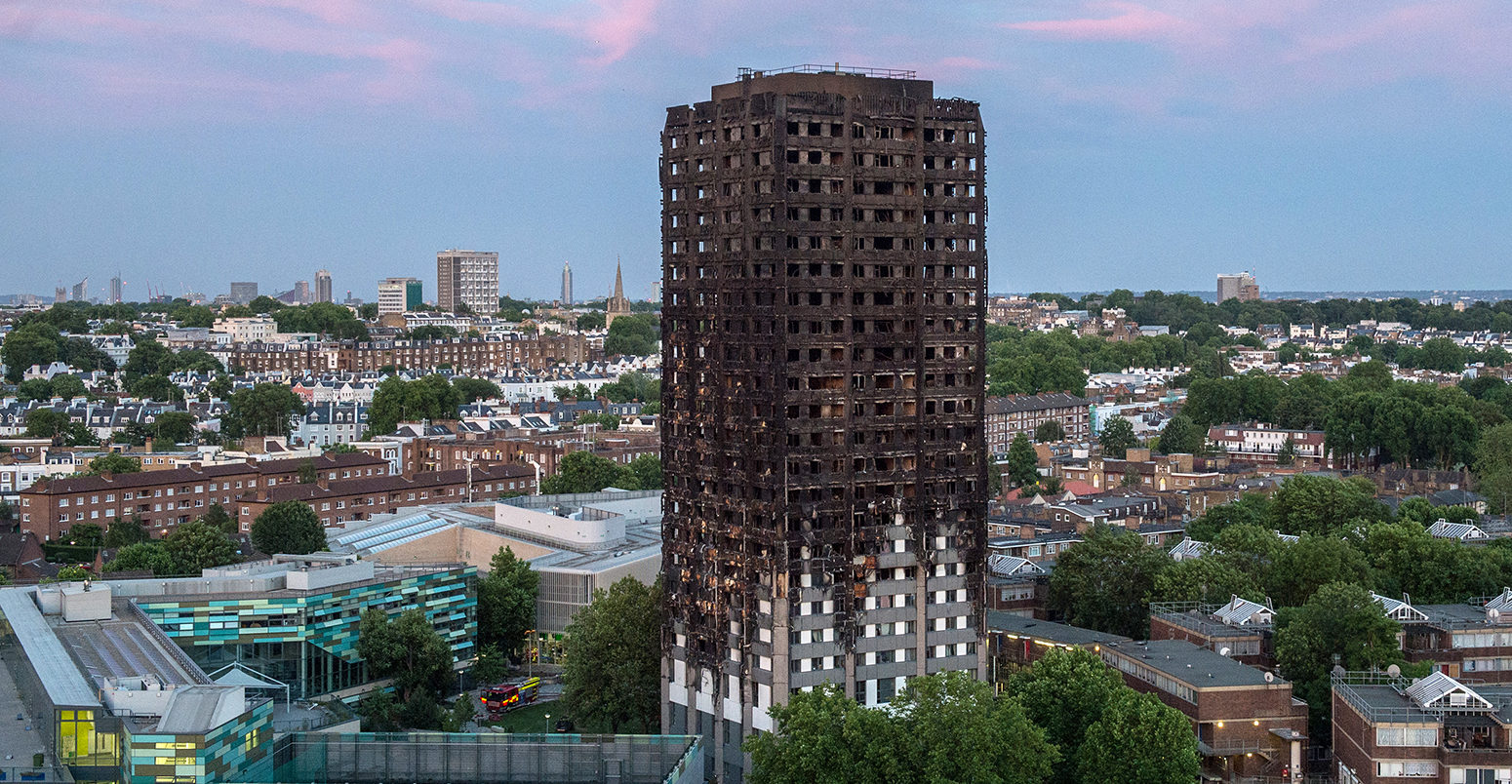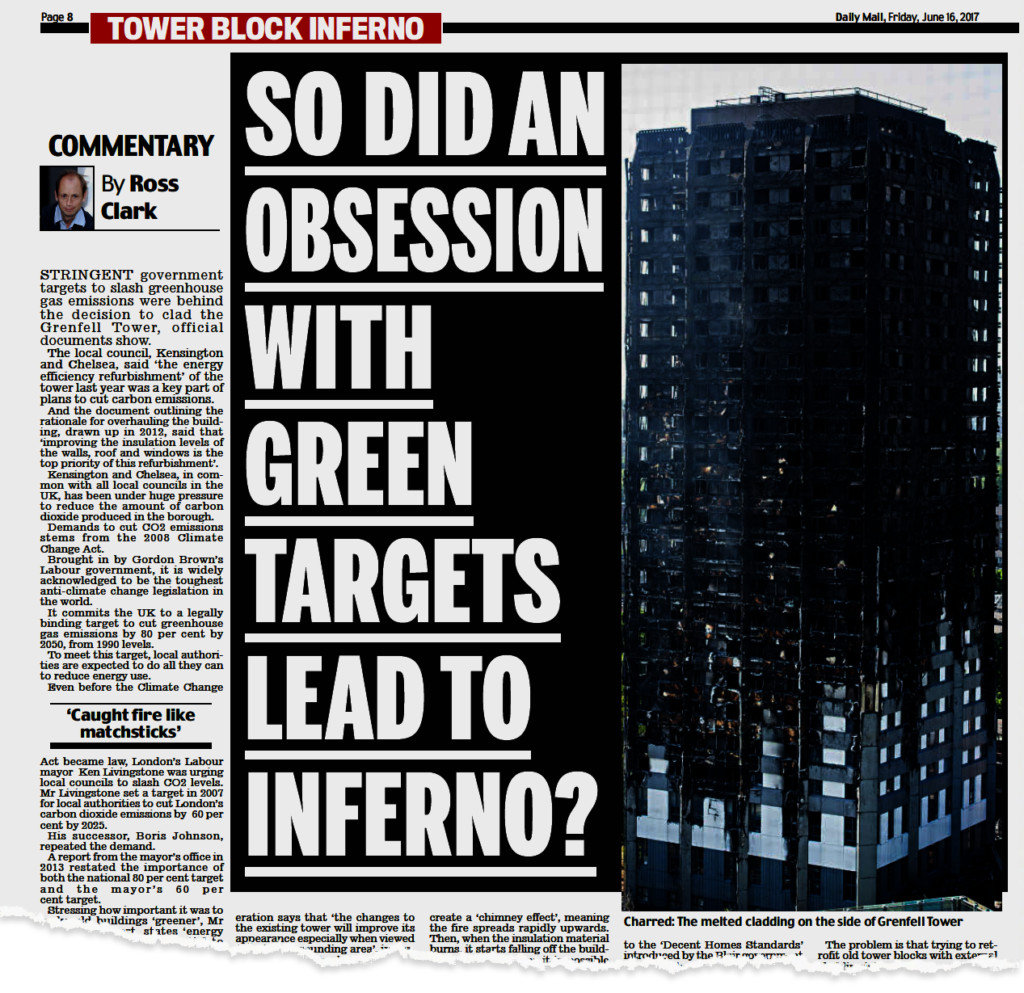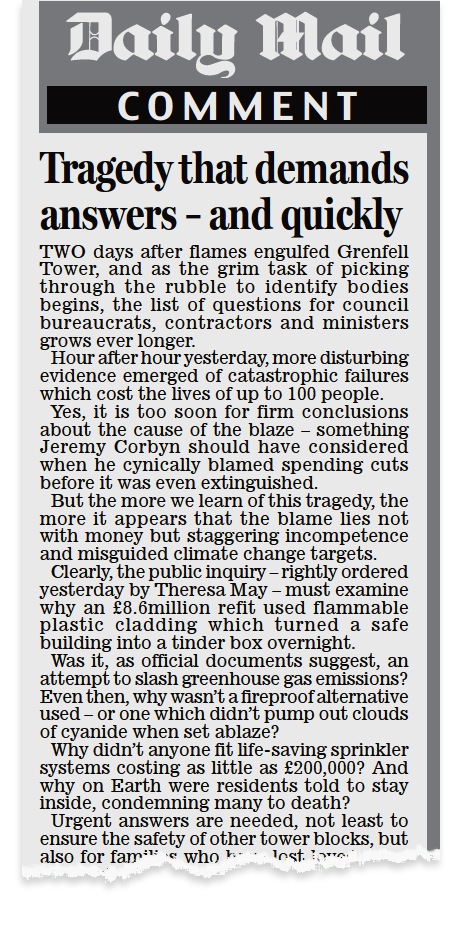
Factcheck: Grenfell Tower fire and the Daily Mail’s ‘green targets’ claim
Leo Hickman
06.16.17Leo Hickman
16.06.2017 | 1:44pmThree days after the devastating fire at Grenfell Tower in west London, much of the media coverage of the tragedy is now focusing on the possible causes.
A wide range of possible contributory factors has been cited – lack of sprinklers, lack of adequate fire escapes, no central fire alarms, etc. But there has been much speculation that the cladding, added to the building during a recent refurbishment, could have helped the fire to spread rapidly up the exterior of the building.
A number of newspapers have focused their investigations on possible cost-cutting during the renovation, as well as prior warnings by residents that safety standards were being ignored. For example, the Times today has a frontpage story highlighting that “contractors could have acquired the fire-resistant version [of the cladding used] for less than £5,000 extra”. The refurbishment of the building cost £8.6m.
However, the Daily Mail is making its own claim. On its frontpage it says there are “three lethal questions” that need answering; the first of which is: “Were green targets to blame for the fire tragedy?” It adds that “experts”, which the paper doesn’t name, are asking whether the cladding was “installed simply to meet environmental targets”.
On page eight is a full-page commentary from Ross Clark, sitting under the headline question: “So did an obsession with green targets lead to inferno?”
Clark, who has published various climate sceptic articles and written a book attacking regulations he believes to be “strangling” the UK, begins the article:
Stringent government targets to slash greenhouse gas emissions were behind the decision to clad the Grenfell Tower, official documents show.
The local council, Kensington and Chelsea, said ‘the energy efficiency refurbishment’ of the tower last year was a key part of plans to cut carbon emissions.
And the document outlining the rationale for overhauling the building, drawn up in 2012, said that ‘improving the insulation levels of the walls, roof and windows is the top priority of this refurbishment’.
Kensington and Chelsea, in common with all local councils in the UK, has been under huge pressure to reduce the amount of carbon dioxide produced in the borough.
Demands to cut CO2 emissions stems from the 2008 Climate Change Act.
He adds:
As well as cladding, the refurbishment included making windows double glazed and installing new energy efficient boilers and heat exchanger units in flats.
Plans to refurbish the tower were drawn up years before – again with a central aim of cutting greenhouse gas emissions.
In 2012 the document explaining the reasons for refurbishing Grenfell Tower, produced by Max Fordham, said: ‘Improving the insulation levels of the walls, roof and windows is the top priority of this refurbishment’.

Daily Mail, 16 June 2017
Primary reason
The 2012 planning documents cited by the Daily Mail – and studied by Carbon Brief – show that its reporting of their content to be highly selective and misleading.
The newspaper’s implication is that cutting carbon emissions to help meet the Climate Change Act was a “key” reason and “top priority” when the council was considering the refurbishment.
However, while they do mention reducing carbon emissions as one of the benefits, the planning documents themselves are quite clear what the primary reason was for the building’s overhaul.
In the introduction to the “planning statement” – the central overview document of the council’s 2012 application submitted by the Kensington and Chelsea Tenant Management Organisation – it states the “context”:
“The need for the regeneration of Grenfell Tower has based upon an assessment of the wider Lancaster West Estate which identified the Tower as the top priority for investment on the Estate. The Tower requires improved thermal efficiency and sound insulation, new heating system, new windows and general improvements to the building and its setting.”
It is not until page six of the 17-page document when “climate change and energy” is first mentioned when listing eight “key themes” that summarise “key national, metropolitan and local planning policy”.
It is only on page 10 when it then gives more information about “Climate change and energy”. It says “the role that planning can play in achieving more sustainable development is at the heart of the NPPF [National Planning Policy Framework]”, adding that the London Plan (the Mayor of London’s “strategic planning” guidance) “sets out overall targets for CO2 emissions and how the planning system can promote their achievement”.
Even though climate change – both in terms of adaptation and mitigation – is now included in most planning guidance, it is not the “key” driver, as implied by the Daily Mail.
Included within the many documents that made up the 2012 planning application for the Grenfell Tower improvements is the “Sustainability & Energy Statement”. It clearly states at the start that the “primary” reason given for the refurbishment was to address complaints by residents that the tower, built in the early 1970s, was overheating in the summer and leaking heat in the winter. This would impact the mostly low-income residents both in terms of their personal comfort and health, but also the cost of their energy bills. It says, in full:
The poor insulation levels and air tightness of both the walls and the windows at Grenfell Tower result in excessive heat loss during the winter months. Addressing this issue is the primary driver behind the refurbishment.
Due to valid safely concerns the windows at Grenfell Towers are restricted to open no more than 100 mm. This restriction causes chronic overheating in the summer months. It is essential that the renovation works do not make the overheating problems any worse and where possible we will strive to reduce overheating in line with current guidelines.
The heating system exacerbates the overheating problem due to its high uncontrolled heat losses throughout the year (including summer) and is also reaching the end of its design life. The client wishes to update the heating system at this point. Updating the heating system allows the disruptive works to ‘piggy back’ on the recladding works.
‘The London Plan July 2011’ aims to conserve energy. A defined energy hierarchy should be followed. This hierarchy is as follows:
1) Be lean: use less energy, in particular by adopting sustainable design and construction measures
2) Be clean: supply energy efficiently
3) Be green: use renewable energy
This approach has been adopted to illustrate the environmental benefits achieved through the refurbishment of the tower.
Retrofitting
As the document stresses in the opening sentence, the refurbishment sought to address “the current energy and environmental comfort problems” of the residents. Within that context, it then shows how the “chosen solutions sit within the London Plan’s aim to bring existing housing stock up to the Mayor’s standards on sustainable design and construction”.
The Daily Mail article by Ross Clark also says:
Stressing how important it was to make old buildings “greener”, a mayor’s report in 2013 states an “energy efficiency retrofit is essential to meeting the mayor’s targets”.
Carbon Brief has examined the cited document and it does not contain the term “greener”, as quoted by the Mail.
The document is titled, “Using local powers to maximise energy efficiency retrofit“. It was published by the then Mayor of London, Boris Johnson, in July 2013.
This is the full sentence that the Mail excerpt above partially quotes: “Given that around 80 per cent of London’s buildings will still be standing in 2050, energy efficiency retrofit is essential to meeting the Mayor’s targets.”
Regarding targets, the mayor’s report says:
Wide-scale energy efficiency retrofit is therefore crucial to meeting both the Government’s target to reduce greenhouse gas emissions by 50 per cent on 1990 levels by 2020 as well as the Mayor of London’s target to reduce London’s carbon emissions by 60 per cent on 1990 levels by 2025.
However, it is worth noting that the report’s foreword also highlights the wider benefits of “energy retrofits”, which reached well beyond the Mail’s claim that the “green targets” were key reason behind cladding being installed:
The opportunity for energy retrofitting in London’s housing is immense: more than one in five of the UK’s solid walled homes are in the capital, as well as 14 per cent of England’s fuel poor homes. And the benefits of attracting funding for retrofit are even greater: reducing our demand for energy resources and helping London’s most vulnerable households out of fuel poverty…
Retrofit also offers wider benefits to the day-to-day lives of Londoners. Making homes cheaper to keep warm reduces fuel poverty and its health impacts. Insulating homes brings them to a higher standard and can overcome chronic issues of poor ventilation and damp. Energy efficiency projects can regenerate entire communities, drive up housing values and engage residents in wider issues of sustainability. Retrofitting also provides an opportunity for pioneering local authorities to get an edge in the growing energy efficiency market and generate local jobs.
The Daily Mail, which has long pursued an anti-climate agenda in its comment pages, also tries to reinforce Clark’s article further with an editorial on page 16. It says:
“The more we learn of this tragedy, the more it appears that the blame lies not with money but staggering incompetence and misguided climate change targets…Was it, as official documents suggest, an attempt to slash greenhouse gas emissions?”

Daily Mail editorial, 16 June 2017
Conclusion
So, to conclude, “green targets” are far from being the “key” driving force behind refurbishing public housing stock. Reducing fuel poverty as well as improving the personal comfort and health of residents are also key motivations, as the planning documents cited above clearly state.
Theresa May, the prime minister, yesterday ordered a full public inquiry into the causes of the disaster. There have also been calls for an interim report to be published this summer. It will likely take months before all the contributory causes are identified and assessed in full.
-
Factcheck: Grenfell Tower fire and the Daily Mail's 'green targets' claim

